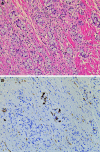Histopathology of gastrointestinal neuroendocrine neoplasms
- PMID: 23346552
- PMCID: PMC3551285
- DOI: 10.3389/fonc.2013.00002
Histopathology of gastrointestinal neuroendocrine neoplasms
Abstract
Gastrointestinal neuroendocrine neoplasms (GI-NENs) arise from neuroendocrine cells distributed mainly in the mucosa and submucosa of the gastrointestinal tract. In 2010, the World Health Organization (WHO) classification of NENs of the digestive system was changed, categorizing these tumors as grade 1 neuroendocrine tumor (NET), grade-2NET, neuroendocrine carcinoma (large- or small-cell type), or mixed adenoneuroendocrine carcinoma (MANEC). Such a classification is based on the Ki-67 index and mitotic count in histological material. For the accurate pathological diagnosis and grading of NENs, it is important to clearly recognize the characteristic histological features of GI-NENs and to understand the correct method of counting Ki-67 and mitoses. In this review, we focus on the histopathological features of GI-NENs, particularly regarding biopsy and cytological diagnoses, neuroendocrine markers, genetic and molecular features, and the evaluation of the Ki-67 index and mitotic count. In addition, we will address the histological features of GI-NEN in specific organs.
Keywords: carcinoid; gastrointestinal tract; neuroendocrine carcinoma; neuroendocrine marker; neuroendocrine neoplasm.
Figures










Similar articles
-
[Prognostic analysis and clinicopathological features of 20 patients with appendiceal neuroendocrine neoplasms].Zhonghua Wei Chang Wai Ke Za Zhi. 2018 May 25;21(5):564-568. Zhonghua Wei Chang Wai Ke Za Zhi. 2018. PMID: 29774940 Chinese.
-
Neuroendocrine Tumor Heterogeneity Adds Uncertainty to the World Health Organization 2010 Classification: Real-World Data from the Spanish Tumor Registry (R-GETNE).Oncologist. 2018 Apr;23(4):422-432. doi: 10.1634/theoncologist.2017-0364. Epub 2018 Jan 12. Oncologist. 2018. PMID: 29330208 Free PMC article.
-
Gastric neuroendocrine neoplasms: A review.World J Clin Cases. 2021 Sep 26;9(27):7973-7985. doi: 10.12998/wjcc.v9.i27.7973. World J Clin Cases. 2021. PMID: 34621854 Free PMC article. Review.
-
[Consensus and controversy on subtype classification of gastric neuroendocrine neoplasms].Zhonghua Wei Chang Wai Ke Za Zhi. 2017 Sep 25;20(9):977-981. Zhonghua Wei Chang Wai Ke Za Zhi. 2017. PMID: 28900986 Chinese.
-
Neuroendocrine Neoplasms: Dichotomy, Origin and Classifications.Visc Med. 2017 Oct;33(5):324-330. doi: 10.1159/000481390. Epub 2017 Oct 16. Visc Med. 2017. PMID: 29177160 Free PMC article. Review.
Cited by
-
Recurrent intussusception in a child revealing a neuroendocrine tumor within a Meckel's diverticulum: a case report.J Surg Case Rep. 2025 Feb 28;2025(2):rjaf085. doi: 10.1093/jscr/rjaf085. eCollection 2025 Feb. J Surg Case Rep. 2025. PMID: 40040771 Free PMC article.
-
Diagnostic Immunostaining and Tumor Markers Predict the Prognosis of Esophageal Neuroendocrine Cell Carcinoma Patients.Ann Surg Oncol. 2021 Nov;28(12):7983-7989. doi: 10.1245/s10434-021-09872-5. Epub 2021 Apr 11. Ann Surg Oncol. 2021. PMID: 33843025
-
Biliary tract large cell neuroendocrine carcinoma: current evidence.Orphanet J Rare Dis. 2019 Nov 21;14(1):266. doi: 10.1186/s13023-019-1230-2. Orphanet J Rare Dis. 2019. PMID: 31752927 Free PMC article. Review.
-
An expression signature of the angiogenic response in gastrointestinal neuroendocrine tumours: correlation with tumour phenotype and survival outcomes.Br J Cancer. 2014 Jan 7;110(1):115-22. doi: 10.1038/bjc.2013.682. Epub 2013 Nov 14. Br J Cancer. 2014. PMID: 24231952 Free PMC article.
-
Neuroendocrine liver metastasis in gastric mixed adenoneuroendocrine carcinoma with trilineage cell differentiation: a case report.Int J Clin Exp Pathol. 2014 Aug 15;7(9):6333-8. eCollection 2014. Int J Clin Exp Pathol. 2014. PMID: 25337287 Free PMC article.
References
-
- Al-Khafaji B., Noffsinger A. E., Miller M. A., Devoe G., Stemmermann G. N., Fenoglio-Preiser C. (1998). Immunohistologic analysis of gastrointestinal and pulmonary carcinoid tumors. Hum. Pathol. 29, 992–999 - PubMed
-
- Alsaad K. O., Serra S., Schmitt A., Perren A., Chetty R. (2007). Cytokeratins 7 and 20 immunoexpression profile in goblet cell and classical carcinoids of appendix. Endocr. Pathol. 18, 16–22 - PubMed
-
- Anlauf M., Perren A., Meyer C. L., Schmid S., Saremaslani P., Kruse M. L., et al. (2005). Precursor lesions in patients with multiple endocrine neoplasia type 1-associated duodenal gastrinomas. Gastroenterology 128, 1187–1198 - PubMed
LinkOut - more resources
Full Text Sources
Other Literature Sources

